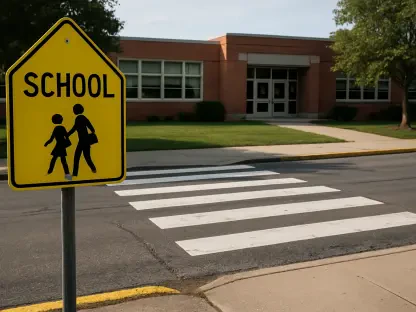The Leon County School District faces a daunting fiscal challenge as it contends with a projected $17 million shortfall for its upcoming budget. Amid declining federal financial support and complexities surrounding grant allocations, the district is tasked with reconciling its budgetary needs without compromising its core educational operations. Current financial forecasts suggest a significant reduction in expected spending, prompting a strategic reassessment of priorities by district leadership. Central to this challenge is Superintendent Rocky Hanna, whose leadership is being tested as he navigates the turbulent financial waters while maintaining operational stability and employment levels.
Confronting Funding Woes
Federal Cutbacks and Local Revenue
In a precarious economic landscape, Leon County Schools illustrate the broader theme of reliance on federal funding juxtaposed against incremental local revenue increases. The district’s anticipated budget reflects a $215 million contribution from state allocations, $19.4 million from federal sources, and approximately $201 million generated through local taxes. Despite these resources, a significant funding shortfall looms as the district navigates the cessation of federal pandemic relief funds and the complications wrought by a freeze on grant disbursement. This backdrop forms a critical juncture where the need for federal dependencies to shore up educational budgets becomes starkly visible.
Leon County’s dilemma mirrors that of many districts nationwide, confronting the reality of eroding federal support. The immediate implications have compelled district leaders to forecast budget cuts, even as state and local revenues show modest increases. As the federal government reassesses its financial involvement with education, Leon County Schools, like others, finds itself on the precipice of significant decisions regarding expenditure controls and resource allocation.
Strategic Responses and Initiatives
Superintendent Hanna’s approach to grappling with the fiscal deficit involves a layered strategy that prioritizes responsible financial stewardship while minimizing disruptions to staff roles and school operations. Critical analysis and potential budget cuts are on the table, potentially affecting staffing, operational expenditures, and district-wide expenses. Notably, Hanna’s commitment to handling the shortfall without resorting to layoffs or long-term employment disruptions reflects a strategic focus on maintaining the district’s workforce stability despite significant financial headwinds.
Efforts to realign fiscal priorities have led to personnel reassignments as federal grants have been temporarily frozen, although layoffs have thus far been averted. Hanna’s nuanced handling of these financial stressors underscores the district’s resilience and commitment to preserving programmatic integrity in the face of dwindling resources. However, the specter of more stringent funding cuts looms large, placing pressure on identifying alternative revenue avenues or executing further cost-cutting measures.
Seeking Solutions through Partnerships
Collaborating with Local Organizations
In seeking to mitigate the financial shortfall and its potential impact on educational programs, Leon County Schools have turned to strategic collaborations with local organizations. A pivotal initiative in this endeavor has been the district’s partnership with the Children’s Services Council, from which it requested $2.1 million to fund afterschool programs. This effort highlights the district’s proactive stance in seeking external funding sources to supplement the shortfall left by waning federal contributions, demonstrating an adaptability and forward-thinking approach to financial management.
The release of over $1 billion in previously frozen federal grants allowed the district to resume its afterschool program operations on more secure financial footing. This development eased the district’s immediate funding concerns and underscored the critical role that local partnerships play in providing essential educational services. While the strategic alignment with local entities has offered some reprieve, persistent uncertainties around future funding necessitate continued exploration of collaborative opportunities to buttress the district’s financial standing.
Navigating Future Challenges
Looking ahead, Leon County Schools must confront lingering concerns about sustainability in an evolving fiscal landscape. Superintendent Hanna’s foresight highlights the potential difficulties awaiting the district if financial conditions remain unchanged. The consideration of school closures and more significant staff reductions in future fiscal years reflects the gravity of the district’s position. Acknowledging these contingencies underscores the urgent need for strategic financial planning and potentially reconsidering funding frameworks to ensure long-term viability.
The path ahead is fraught with challenges, yet it is also imbued with opportunities to rethink district funding strategies. Hanna’s candid acknowledgment of the framework’s fragility spotlights the importance of resilience and adaptability in educational administration. Proactive measures, strategic partnerships, and innovative financial planning remain crucial as the district navigates the complexities and demands of modern educational finance.
Toward Sustainable Financial Practices
The Leon County School District is facing a significant financial hurdle with a looming $17 million budget deficit for the upcoming fiscal year. This challenge is exacerbated by dwindling federal financial aid and the intricacies involved in managing grant funds. The district is under pressure to balance its financial needs without undermining its primary educational functions. Forecasts indicate a substantial decrease in planned expenditures, pushing district leadership to strategically rethink its priorities. At the center of this fiscal storm is Superintendent Rocky Hanna, who must demonstrate strong leadership skills to steer the district through these turbulent times. He is challenged with the task of maintaining both stability in day-to-day operations and current employment levels. His leadership is crucial as the district seeks innovative solutions to bridge the budget gap, ensuring that the quality of education and support for students remains intact despite the financial constraints they face.









